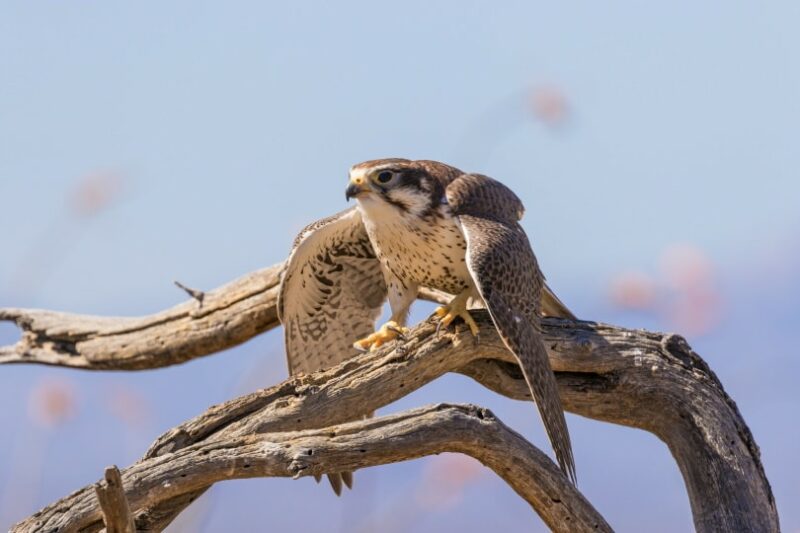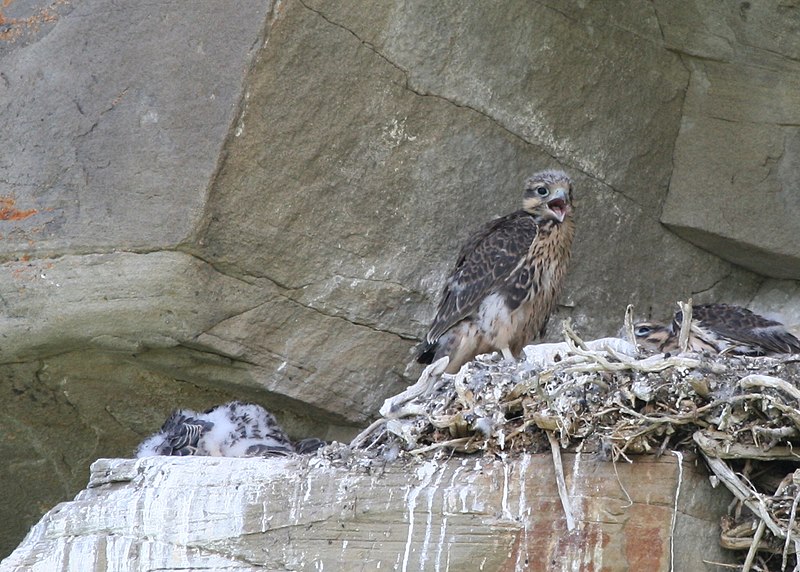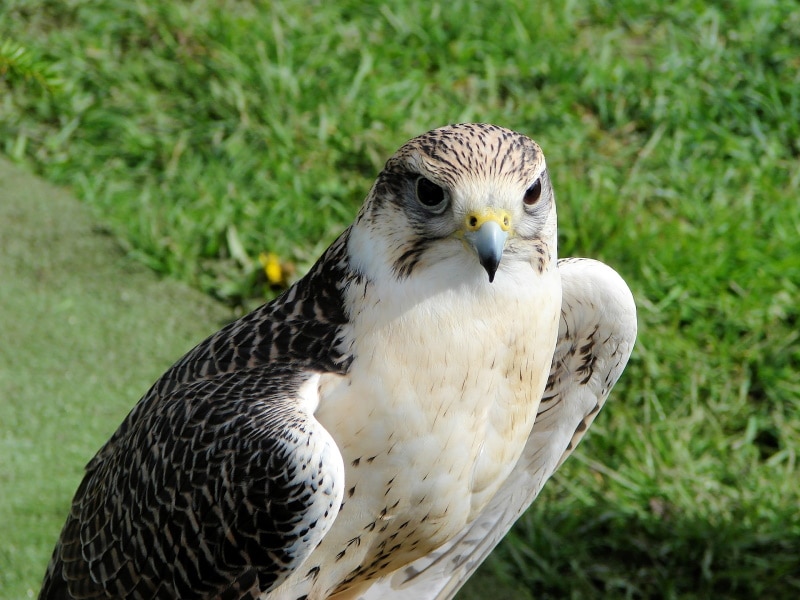Prairie Falcon: Field Guide, Habitat, Pictures & Info
Last Updated on

Birds of prey are some of the most awe-inspiring creatures on our planet. Their jagged talons, confident stature, and watchful eye make them a popular group for birders to seek out. The prairie falcon is one of these apex predators, and they have some unique traits that make them stand out from the rest.
Below we’ll dive into all the information you need to know about them, as well as high-quality images to show you a closer look!

Quick Facts about the Prairie Falcon
| Habitat | Prairie grasslands, dry deserts |
| Diet | Small birds and rodents |
| Behavior | Aerial hunter |
| Nesting | Cliffs and buffs |
| Conservation | Low Risk |
| Scientific name | Falco mexicanus |
| Lifespan: | 13–20 years |
Prairie Falcon General Description
Named after its prominence in the western prairie, this member of the falcon family is one of the most familiar birds of prey in the western United States. The prairie falcon has a classic brown and gray coat, with a white and brown underbelly that beautifully patterns beneath its wings. Sharp, yellow talons serve well for perching and for offensive/defensive strikes, along with a curved, overlapping beak that most predatory birds share.

Prairie Falcon Range, Habitat, Behavior, Diet, and Nesting
Range
Prairie falcon populations range throughout the greater half of the western United States, extending from Minnesota to the Pacific coast and the U.S-Canada border to central Mexico. However, that range is only dominant during the mating off-season. You may be able to see them in mating season, but their range concentrates further west and into inland states as well as the north-central region of Mexico.
Habitat
The prairie falcon is a resident of deserts of the American southwest and Mexico, but it also calls home to the prairie grasslands as the name suggests. This species perches on large branches and dead trees, but you may also notice that they are in areas concentrated with cliff sides and mountains nearby.
Behavior
This gray-coated bird is not a fan of other birds. In cases with other large birds or owls nearby, prairie falcons are known to attack and defend their territory. Additionally, this species enjoys dust-bathing, as their environment is dry and the water supply isn’t worth the cost of hydration.
Diet
Prairie falcons hunt and eat smaller birds, as well as small mammals such as desert mice or rabbits. They may also go after snakes or lizards in the desert, but their acrobatics in the sky help them pursue flying prey quite easily.
Nesting
The places you’ll find the highest share of prairie falcon nests are rocky cliffs and sandstone buffs. Badlands and desert monoliths are popular nesting spots where you can see them flying to and from, but generally, they are covered for protection against the elements.

How to Find Prairie Falcons: Birdwatching Tips
What to Listen For
Actively listen for the loud calls of two falcons, a mating ritual that the male and female both participate in. You can also listen for birds that may indicate that you are on hunting grounds.
What to Look For
Look out for cliffs and sandstone buffs in the western U.S. that have minimal forestation. They commonly fly in the open, where they can be seen from afar. Keep your eyes out for small birds that are perched on bushes and shrubs—one may be scouting this area for a meal.
When to Look
When it comes to prairie falcons, the best time to look for them is any time of day when natural light is visible. They hunt during the day and dusk or dawn.
Attracting Prairie Falcons to Your Backyard: Tips & Tricks
Unfortunately, it isn’t the best idea to bring prairie falcons close to humans. These birds may attack pets or livestock if they are desperate for food and may be aggressive towards people if they feel threatened. Not only that, but it’s unlikely that they will even consider going near established towns or backyards. However, it may be possible to see them if you have a ranch or live in rugged terrain; they may live nearby!

Prairie Falcon Conservation: Is this Bird Threatened?
The prairie falcon is not currently threatened in terms of its overall population. Still, there are some changes in its range that have been affected by climate change. The species is found in rural areas, so any industrialization or construction will destroy their habitat in the backcountry.

Final Thoughts
As one of the iconic predatory birds in the west, the prairie falcon is a sight to behold; its striking eyes and hunting mastermind make it an incredible experience for birders of any kind. However, they aren’t your everyday bird, so you may have to get on the trails and whip out binoculars to get a better look. If you’re a resident or traveler in the west, you’ve got to check out this falcon in action!
Featured Image Credit: Tom Tietz, Shutterstock
Table of Contents
About the Author Robert Sparks
Robert’s obsession with all things optical started early in life, when his optician father would bring home prototypes for Robert to play with. Nowadays, Robert is dedicated to helping others find the right optics for their needs. His hobbies include astronomy, astrophysics, and model building. Originally from Newark, NJ, he resides in Santa Fe, New Mexico, where the nighttime skies are filled with glittering stars.
Related Articles:
10 Types of Hummingbirds in Arkansas (With Pictures)
8 Types of Hummingbirds in Nebraska (With Pictures)
5 Types of Hummingbirds in Idaho (With Pictures)
3 Types of Hummingbirds in Mississippi (With Pictures)
8 Types of Hummingbirds in Kansas (With Pictures)
5 Types of Hummingbirds in West Virginia (With Pictures)
5 Types of Hummingbirds in Ohio (With Pictures)
Where Do Nuthatches Nest? Nuthatch Nesting Habits Explained
